How to Use Resistance Band Workouts for Strength and Muscular Endurance
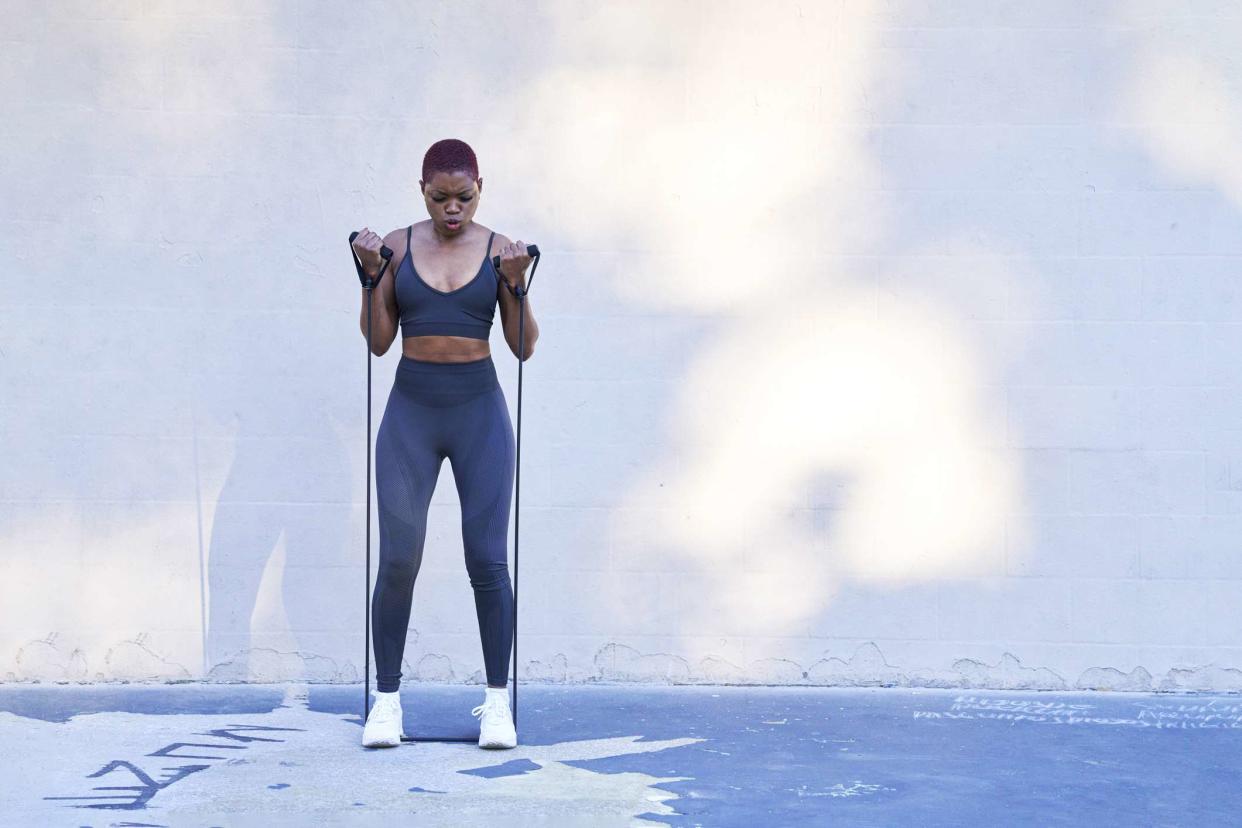
Heshphoto / Getty Images
Medically reviewed by Kristin McGee, CPT
Resistance bands are effective and versatile tools for people of all fitness levels. These stretchy bands provide a unique form of resistance training that is different from traditional weightlifting. They are also useful for building muscle strength and endurance and are excellent for improving flexibility and rehabilitation from injuries.
Resistance bands come in various styles, but what sets them apart is their portability, affordability, and easy setup. These characteristics make them a practical choice for people with busy lifestyles or limited access to gym equipment.
They are also easy to get started with and suitable for beginners and fitness buffs alike. The varying resistance levels allow for customizing the intensity of your workout, and because they provide resistance from all angles, they work your muscles differently than weights bound to gravity-based resistance.
While resistance bands are not necessarily the optimal choice for building muscle size, they do offer benefits for leveling up your stretching routine, yoga practice, and even Pilates moves. Below, you'll learn more about resistance bands and find some workouts that'll allow you to incorporate them effectively into your fitness routine.
Related: How Effective Are Resistance Bands?
Getting Started With Resistance Bands
Resistance bands are available in various styles suitable for strength and flexibility training. Understanding the types of bands and how to use them will help you determine which works best for your particular goals or training style. Here's what you need to know about the types of resistance bands and how to choose the right one for you.
Types of Resistance Bands
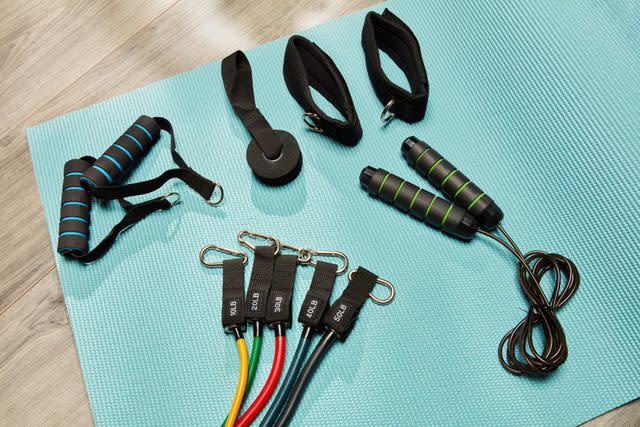
Verywell Fit / Connor Ralph
There are three primary types of resistance bands—loop bands, tube bands, and power bands. Here's what you need to know about each.
Loop Bands
These closed-loop bands are perfect for lower-body exercises. Their circular shape allows for natural resistance during squat, hinge, or lunge variations, making them a favorite for those looking to strengthen and build muscle in their legs and glutes.
Wrap them around your ankles or thighs to introduce an extra challenge to exercises like banded squats, lateral band walks, or fire hydrants. As for upper body exercises, their closed design might limit some movements.
Tube Bands
Versatile and ideal for a full-body workout, tube bands are typically used for exercises like the banded pull-apart or tricep extensions. Unlike loop bands, tube bands are longer and do not form a loop. Their length allows for an extensive range of motion, though they aren't as practical for targeting lower-body muscles.
Tube bands typically have handles or can attach to other accessories at the ends. Many tube band sets also come with a door anchor, allowing them to be used similarly to a cable machine. Tube bands are ideal for rows, bicep curls, triceps extensions, and shoulder presses.
Power Bands
Power bands—also known as assist bands or strength bands—provide much higher resistance and are thicker than other bands. Many people use them to reduce some of the load during bodyweight exercises like pull-ups.
However, they are useful for more than just assistance exercises and come in a range of resistance levels, making them ideal for warm-up movements before lifting. Power bands also are effective for helping open and activate your hips, shoulders, and back and can be used for seated rows, face pulls, pull-aparts, and overhead presses.
Choosing the Right Resistance
Selecting a resistance band with the proper resistance for you is essential for maximizing your workouts. Bands come in various resistance levels for different exercises and fitness levels. Using bands with less resistance is best for smaller muscle groups and warm-up movements, while larger movements and muscles may need more resistance.
Beginners using resistance bands to build strength should start with lighter resistance, focusing on perfecting their form and technique. As you progress, you can gradually increase the resistance to keep your muscles challenged and ensure you are progressively overloading them, which is crucial for results.
Tips for Effective and Safe Band Use
Consistent tension: Ensure your band is free from slack throughout the exercise. Slack in the band reduces effectiveness and could lead to improper form. Just make sure not to stretch the band too much, which could cause it to weaken or snap.
Slow and controlled movements: Avoid snapping or jerking the band. Control your movements to engage the target muscle groups and prevent injury, and use control through a full range of motion for the best results.
Proper posture and alignment: As with all exercises, maintaining correct posture is essential for preventing strain and injury. Align your body correctly to engage the intended muscles and avoid placing bands on your joints. Stick to areas such as thighs, lower legs, forearms, and upper arms, or hold them in your hands.
Upper Body Resistance Band Exercises
Resistance bands are ideal for several upper-body exercises. Here are a few movements to try.
Banded Pull-Apart
The banded pull-apart is an effective exercise for warming up and activating the upper back posture muscles. You can modify the intensity of this exercise by varying the distance between your hands on the band.
Ensure your movement is slow and controlled to avoid snapping the band back. While performing the exercise, maintain the band at chest level, and don't hunch your shoulders. Here's how to get started.
Grasp the middle of the band with both hands and extend your arms straight in front of you with your hands spaced a few inches apart.
Squeeze your shoulder blades together as you pull the band apart, extending your arms to the sides.
Return to the starting position gently, maintaining tension on the band throughout.
Perform this movement with control, focusing on engaging your shoulders and upper back muscles.
Lat Pulls
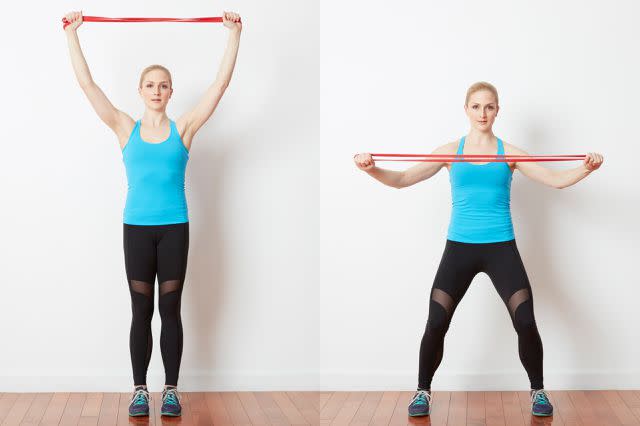
Verywell / Ben Goldstein
Lat pulls are an excellent exercise for targeting the latissimus dorsi muscles on each side of your back. This exercise requires concentrated effort for maximum effectiveness. If you have shoulder impingement or feel any discomfort in your shoulder joints, it's best to avoid this movement. Here is how to do a lat pull.
Begin by standing or sitting, holding a band overhead with both hands.
Position your hands a few inches apart, adjusting as necessary to achieve the proper tension.
Keep your left hand stationary while using your back muscles to pull the right elbow down toward your ribcage.
Return slowly to the starting position.
Complete 16 repetitions before switching to the other side.
Banded Row
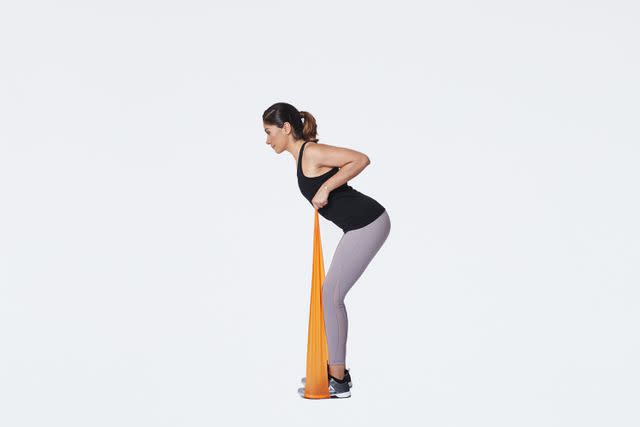
Verywell / Ben Goldstein
A standing row targets the deltoids, lats, traps, and biceps, making it a great choice for developing upper body strength and muscular endurance. Here's how to do a banded row.
Position yourself with your feet hip-width apart, standing to face the point of attachment.
Hold the handles with your thumbs pointing upward, keeping them at chest level.
Bend your knees slightly for stability.
Draw the handles toward your armpits by pulling back your elbows.
Return your arms to the initial position and continue the movement for subsequent repetitions.
Banded Chest Press
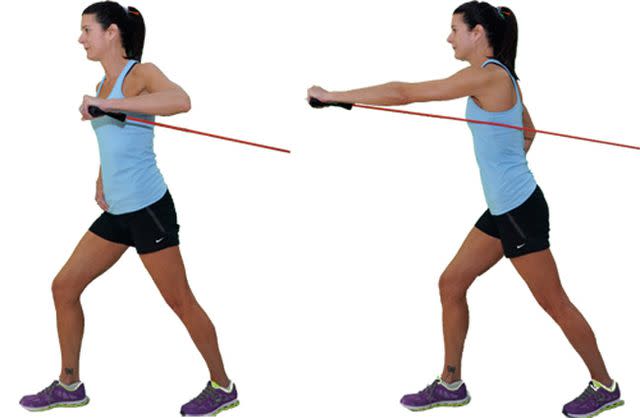
The one-arm banded chest press is an excellent exercise for targeting the chest muscles and core, requiring you to maintain stability throughout the movement. Keep your hips steady and avoid arching or hyperextending your back. Concentrate on bracing your core and isolating the movement to just your arm, feeling the contraction in your chest. Here's how to get started.
Anchor the band to a solid object behind you, threading one handle through the other to secure it.
Grasp the end with your left hand and step forward until the band is taut.
Start with your left arm bent, positioning the band under your arm and your elbow at a 90-degree angle, palm facing downward.
Engage your chest muscles to press your left arm forward.
Return to the starting position.
Repeat this process for the desired number of repetitions.
Lower Body Resistance Band Exercises
Bands are particularly useful for glute isolation work, but they can also be effective for warming up your legs before other movements or as stand-alone exercises to build muscular strength and endurance. Here are some lower body exercises to try.
Banded Bridge
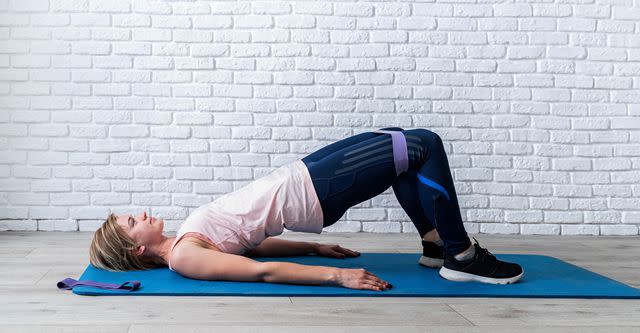
Ilona Shorokhova / Getty Images
Glute bridges are an excellent hinging exercise for targeting the glutes and can build mind-muscle connection as part of a warm-up or address lower back pain. These movements can be enhanced by incorporating a band for added resistance at the peak contraction of the movement and can help you learn to push your knees out to engage the lateral glute and thigh muscles. For this movement, use a loop band placed around your thighs. Here's how it's done.
Start by lying on your back on an exercise mat, feet flat on the floor, and knees bent.
Place the resistance band across your hips, holding the ends at your sides, or position a loop band around your thighs.
Elevate your hips, pushing against the band's resistance, until your body forms a straight line from your shoulders to your knees.
Press your thighs outward against the loop band to maintain glute activation.
Hold momentarily at the top of the movement, then gradually lower your hips to the floor.
Band Glute Kickback
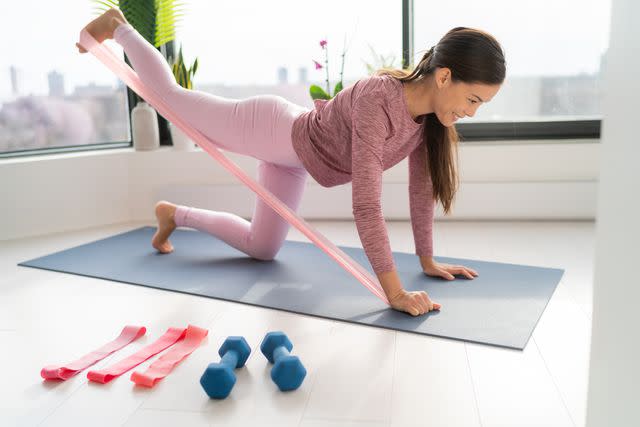
Maridav / Getty Images
Hip extension plays a pivotal role in daily activities such as standing, stepping, and walking, as well as in sports movements like running, jumping, and sprinting. Glute kickbacks, also known as donkey kicks are a glute isolation exercise that uses hip extension.
This movement specifically targets the gluteus maximus, the largest muscle in the gluteal region. Here's how to get started.
Position yourself on the floor on your hands and knees.
Hold each end of a resistance band in your hands, with the middle of the band looped around your right foot.
Ensure the band is tight.
Keep your core engaged and your spine neutral as you extend your right leg behind you, raising it slightly upward.
Return your leg carefully to the initial position, maintaining control throughout the movement.
Avoid letting your knee or toes touch the floor before completing all the repetitions.
Banded Walking Lunge
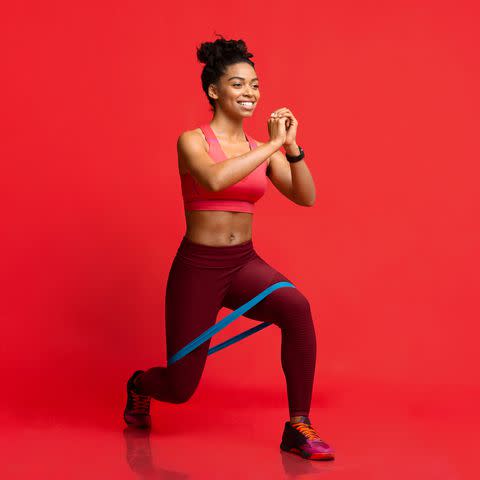
Prostock-Studio / Getty Images
Walking lunges are an incredibly effective and functional bodyweight exercise that works your entire lower body. They can be adapted to focus more on the quads by staying upright or the glutes by leaning forward and taking larger steps.
You will need enough space to take consecutive wide strides. But you can always use a hallway in your home, turning and coming back the other way if required. Here's how to do a walking lunge.
Stand with your feet about hip-width apart, with your torso upright and tall.
Engage your core, pull your shoulders back, and lift your chin.
Maintain your gaze straight ahead.
Step forward about two feet with your right foot and bend both knees. Inhale, lowering your back knee toward the floor. Tap down, or stop just before it touches.
Push through your right foot, extending your right knee to rise back up, exhaling as you do.
Lift your left foot off the ground and bring it forward with control to step about two feet ahead of your right foot.
Keep your torso from leaning forward as you step.
Continue stepping forward, alternating legs with each lunge. If you lose balance, pause at the top of each lunge when your feet are together, regain your balance, and then proceed.
Complete your set by bringing your back foot forward to meet your front foot on the final lunge.
Related: 12 Great Lunges for the Hips, Glutes, and Thighs
Example Full Body Resistance Band Workout
Try combining a few resistance band exercises to form a full-body resistance band workout. Here's a sample workout you could try.
Pull-apart: Warm up set of 20 to 30 reps
Bridge: Warm up set of 20 to 30 reps
Banded row: Three sets of 10 to 20 reps
Chest press: Three sets of 10 to 12 reps
Walking lunge: Two sets of 10 to 15 reps per leg
Glute kickback: Four sets of 15 to 20 reps
More Workout Options
Here are some additional resistance band workouts for your upper and lower body routines.
Read the original article on Verywell Fitness.

